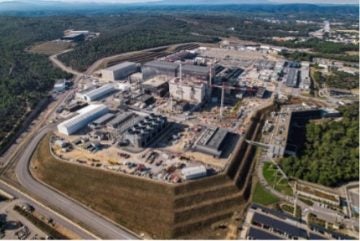
At the 34th meeting of the ITER Council, the ITER Organisation, with support from the Domestic Agencies, submitted a proposed update to the project baseline for the Council’s consideration. The previous baseline, established in 2016, was for first plasma in 2025 at the International Thermonuclear Experimental Reactor (ITER) under construction in France.
ITER is a first-of-a-kind global collaboration. As the host, Europe contributes almost half of the costs of its construction (45.6%), while the other six members of this joint international venture (China, India, Japan, South Korea, Russia and the US), contribute equally for the remaining expenses (9.1% each). However, in practice, the members deliver little monetary contribution to the project, instead providing ‘in-kind’ contributions of components, systems or buildings.
The goal of ITER is to operate at 500 MW (for at least 400 seconds continuously) with 50 MW of plasma heating power input. Some 33 nations are collaborating in the construction of ITER, which began in 2010, many of them through their Domestic Agencies (DAs).
The proposed new baseline “designs a path to a scientifically and technically robust initial phase of operations, including deuterium-deuterium fusion operation in 2035 followed by full magnetic energy and plasma current operation”.
The Council reaffirmed that the fusion operations pursued by ITER remain strongly relevant for global fusion research and development and the national fusion programmes of the ITER members. The proposed baseline will be further evaluated, including the cost and schedule implications, before the Council reconvenes in November 2024.
During the two-day meeting, the Council also received reports on the progress of construction (including repairs of key components), manufacturing, assembly, and licensing and welcomed the engagement of the project with private fusion sector initiatives.
ITER Director-General Pietro Barabaschi reported on the progress of the ITER Project, reflecting the efforts of the ITER Organisation and DAs to position the project for success and strengthen its central position in global efforts to deploy a cleaner, reliable and abundant energy source.
In November 2022, Pietro Barabaschi, who was appointed director general two months earlier, launched a programme of project reform, with support of the DAs and under the supervision of the Council. These reforms included streamlined project management, heightened attention to quality control, and enhanced reporting. In addition, they addressed the need to develop a revised project baseline, due to delays caused by the Covid19 pandemic and technical challenges linked to the first-of-a-kind nature of many components.
Barabaschi said then that defects had been identified in two key tokamak components, the thermal shields and the vacuum vessel sectors. He warned that the consequences on schedule and cost ”will not be insignificant”. One problem, he said, was incorrect sizes for the joints of blocks to be welded together for the installation’s 19 x 11 metre chamber. The second was traces of corrosion in a thermal shield. Fixing the problems “is not a question of weeks, but months, even years,” he noted.
The proposed new baseline would prioritise the start of substantial research operations as rapidly as possible. This would be achieved by consolidating tokamak assembly stages, enhancing pre-assembly testing, and reducing machine assembly and commissioning risks. Throughout this phase of assembly, the project will continually progress through critical technical milestones that will be relevant to the global fusion innovation programme.
As to the current situation, the Council noted the progress achieved on repairs to key components – the vacuum vessel sectors and thermal shield – as well as ongoing manufacturing, assembly, and installation. Manufacturing of all poloidal field coils has also been completed. These are examples of the critical milestones the project will accomplish throughout the assembly phase. The first three central solenoid modules have been stacked and are being aligned while the fourth central solenoid module has arrived at ITER. Installation of magnet feeders is ongoing in the tokamak pit. Multiple support systems have been commissioned or are in the commissioning process.
In response to the Council’s November 2023 request for ITER to engage with private sector fusion initiatives, a workshop hosted in May welcomed more than 300 participants. These included representatives from global fusion start-ups, supplier companies, research institutes, national laboratories, universities, NGOs, and government agencies. The attendees reaffirmed the importance of the ITER mission and research programme as an essential complement to private sector fusion R&D.
The Council noted the ongoing challenges facing the project and expressed appreciation that all ITER members are continuing to meet their in-kind and in-cash commitments to support project success.






